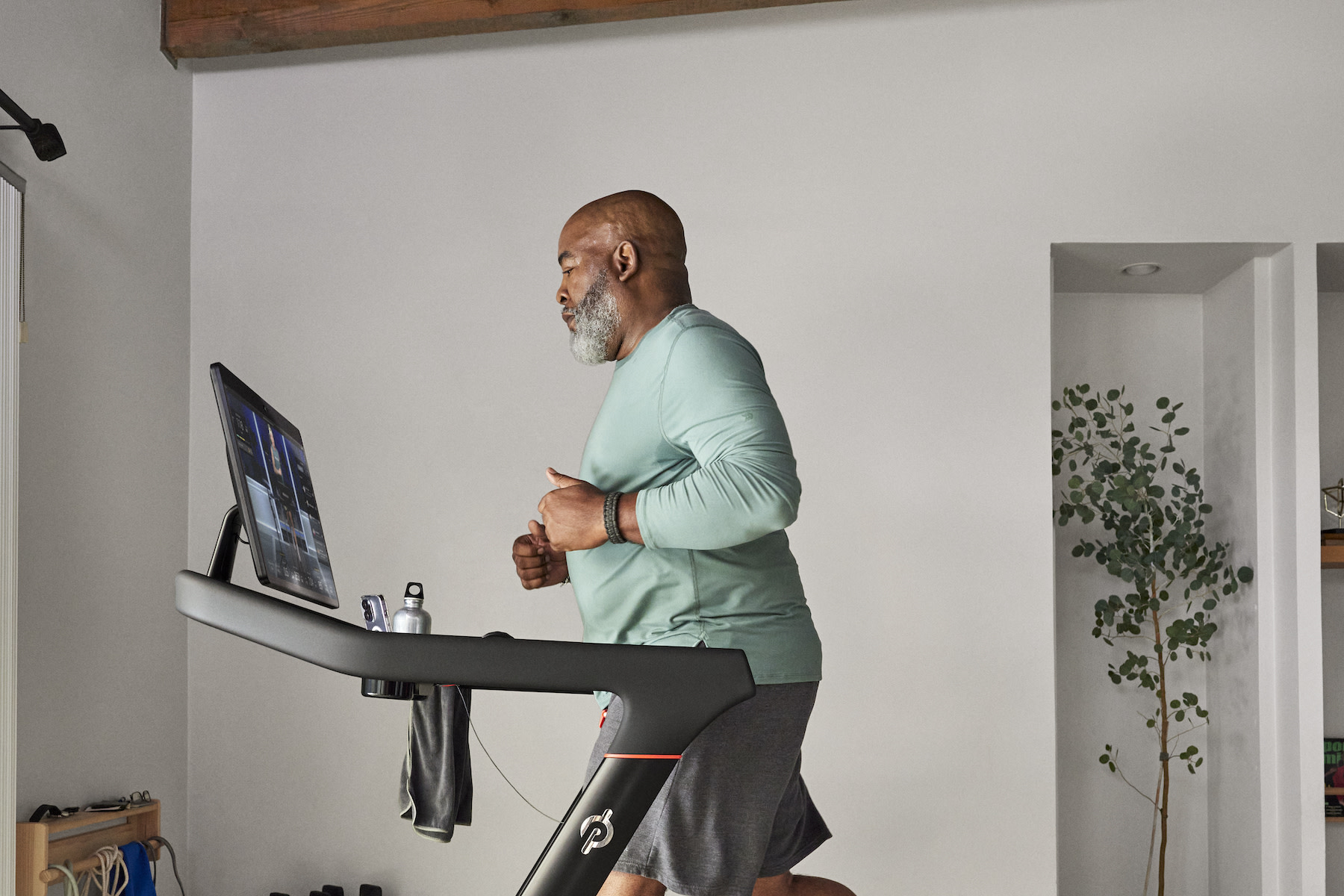
How to Choose Between Incline Walking and Running, Depending on Your Fitness Goals
The experts weigh in on these cardio workouts.
By Natalie Arroyo Camacho•
The Benefits of Incline Walking
The Benefits of Running
Incline Walking vs. Running: How to Find the Best Option for You
Incline Walking vs. Running: How to Do Both
You may think that running is the best cardio workout there is. And while you may not be wrong, don’t rule out the power of incline walking.
“There's this misconception that if you’re not pushing yourself and your body to complete exhaustion, then it's not a workout,” says Peloton instructor Kirsten Ferguson. That’s a myth. Incline walking comprises a large part of Kirsten’s own workout regimen because it’s “one of the most beneficial workouts that you can do," she says. "It’s low impact, and you can get the same output in a hike as you can in a run."
When it comes to your heart health, either workout can be beneficial. “Incline walking and running are both great options for improving cardiovascular health and overall fitness,” says Amar Shere, MD, an non-invasive cardiologist at Atlantic Health System in New Jersey. Perhaps that’s why there’s a question that comes up when talking about those two cardio choices: Which one should you pick?
Below, Dr. Shere and Kirsten explain why you might choose incline walking over running (and vice versa), as well as the benefits of each modality.
The Benefits of Incline Walking
Walking on any incline counts as an incline workout—really. Even if you’re just at an incline of one percent, you’re doing an incline walk. However, the higher the incline is set, the more difficult your workout becomes, giving you more opportunities to build strength, Dr. Shere adds.
That’s because, over time, your body adjusts to the effort, Kirsten says. “The higher up you go, the more you're going to activate your posterior chain,” she says. Here, we break down some of the key benefits of incline walking.
It Builds Strength
Walking on an incline works more muscle groups than strolling on a flat surface. Incline walking activates and strengthens the muscle groups in your lower body—including your legs, calves, quads, hamstrings, and glutes, Dr. Shere says. (It also engages your core.)
It Increases Your Endurance
“Walking on an incline…requires the heart to work harder to pump blood throughout the body,” Dr. Shere says. “This strengthens the heart muscle and improves overall cardiovascular fitness.” Kirsten agrees, noting that many incline walking classes on the Peloton Tread take you to the maximum incline. “That will jack your heart rate up,” she says. “It's a beautiful way to get the workout in and done without putting so much of a load on your body,” she says.
It’s Easier on Your Joints
If you’re a runner, you likely know that you often feel those miles on your joints. Incline walking is “much gentler” on your joints, Dr. Shere says, adding that it reduces the impact placed on your knees, hips, and ankles—potentially making it a safer option if you have joint pain or arthritis.
It May Feel More Accessible
Kirsten says that one of the often overlooked benefits of incline walking is how approachable it is for most people. “[Incline walking] is a beautiful place to start because you are going to build that cardio endurance, you're going to build power,” she says. That could even open you up to running down the road. She speaks from personal experience. “I'm just coming back from hip surgery,” she adds. “Hiking was one of the workouts that really helped me build back my strength before I could start to run.”
The Benefits of Running
According to data collected between 2010 and 2021, roughly 50 million Americans went on at least one run annually. As one of the oldest forms of personal fitness, there’s no denying the popularity of running.
“Different types of running are super beneficial for your cardiovascular health,” Kirsten says. And if you’re worried that running will wreak havoc on your joints, it’s worth pointing out that the cushioned slat belt on the Peloton Tread+ can help reduce the strain.

Peloton Treadmills
Two treadmills. One Peloton experience.
It Enhances Your Aerobic Capacity
Running leads to a higher VO2 max, Dr. Shere says. “VO2 max quantifies the maximum rate at which you can intake oxygen via your respiratory system, transport it to your muscles via the circulatory system, and use it efficiently for aerobic energy production,” he says. Essentially, running increases your aerobic capacity by making you control your breath.
It Burns More Calories
If burning calories is a goal for you, consider breaking into a stride. “Running burns a significant amount of calories due to its high-intensity nature, which helps create a calorie deficit,” Dr. Shere says. For reference, you burn about 100 calories for each mile that you run—assuming you’re at a pace between 10 and 12 minutes. Running for an hour can help you burn anywhere between 500 and 700 calories.
It Strengthens Your Bones
As weight-bearing exercises, both running and walking can help you build stronger and denser bones. However, due to the increased speed when you run, compared to incline walking, running may have a more pronounced effect on your bone density. Running helps accumulate a higher concentration of calcitonin, parathyroid hormone, and vitamin D—all which increase your bone density.
Incline Walking vs. Running: How to Find the Best Option for You
Simply put, prioritize the modality that you’ll do on a regular basis, Dr. Shere says. “If you enjoy one workout over the other, you are more likely to stay consistent with it and will see greater results,” he adds. If you’re running even though you’re not a fan of it, you’re not likely to continue that workout—and vice versa. Make sure to listen to your body. If you have arthritis or joint pain, running can be not only uncomfortable but also potentially dangerous. In this case, you may want to stick with low-impact activities, such as incline walking.
If you enjoy both types of workouts, Kirsten suggests asking yourself a series of questions:
What have you done for the week?
What's the load on your body?
Are you also doing some sort of strength work?
How are you balancing all of your workouts?
“I'd want to know what you've already done and what your goal is,” she says. “If you've done a lot already for the week, maybe it is time for an incline walk,” she says. “It really depends on where you are in your week and what your workload has been on your body. I’d take it from there.”
As always, listen to your body to see if it’s communicating any pain or discomfort. If you feel pain in the muscles or joints that you use for your typical workout, you might want to take a rest day or consider cross training—which is doing a different workout than your primary movement.
Incline Walking vs. Running: How to Do Both
Incline walking and running don’t need to be mutually exclusive. In fact, you might find it beneficial to do both. And according to Kirsten, incline walking and running go hand in hand.
“If you're marathon training and you need a recovery day, incline walking is a perfect way to get active recovery…because you're not doing the running part,” she says. Incline walking can also help you prepare for your runs, she adds.
Dr. Shere concurs. “Integrating incline walking and running into your workout routine is a highly effective approach to achieving overall health,” he says. Combine them both into one cardio session or spread them out over the course of the week. Either way, you’re reaping the benefits of these two modalities.
Hitting both of these workouts in the same session will give you a guaranteed sweat session. If you choose to do so, Dr. Shere recommends beginning with incline walking. “Then, transition to running for the remainder of your aerobic exercise,” he adds. To finish off your workout, cool down and recover by walking on a low incline. If you alternate between incline walking and running on different days, you’ll keep your routine fresh—and give your muscle groups time to recover, he adds.
This content is for informational and educational purposes only and does not constitute individualized advice. It is not intended to replace professional medical evaluation, diagnosis, or treatment. Seek the advice of your physician for questions you may have regarding your health or a medical condition. If you are having a medical emergency, call your physician or 911 immediately.
Level up your cardio workouts
Enter your email to get articles, instructor tips, and updates from Peloton sent to your inbox.
By providing your email address, you agree to receive marketing communications from Peloton.
For more about how we use your information, see our Privacy Policy.










